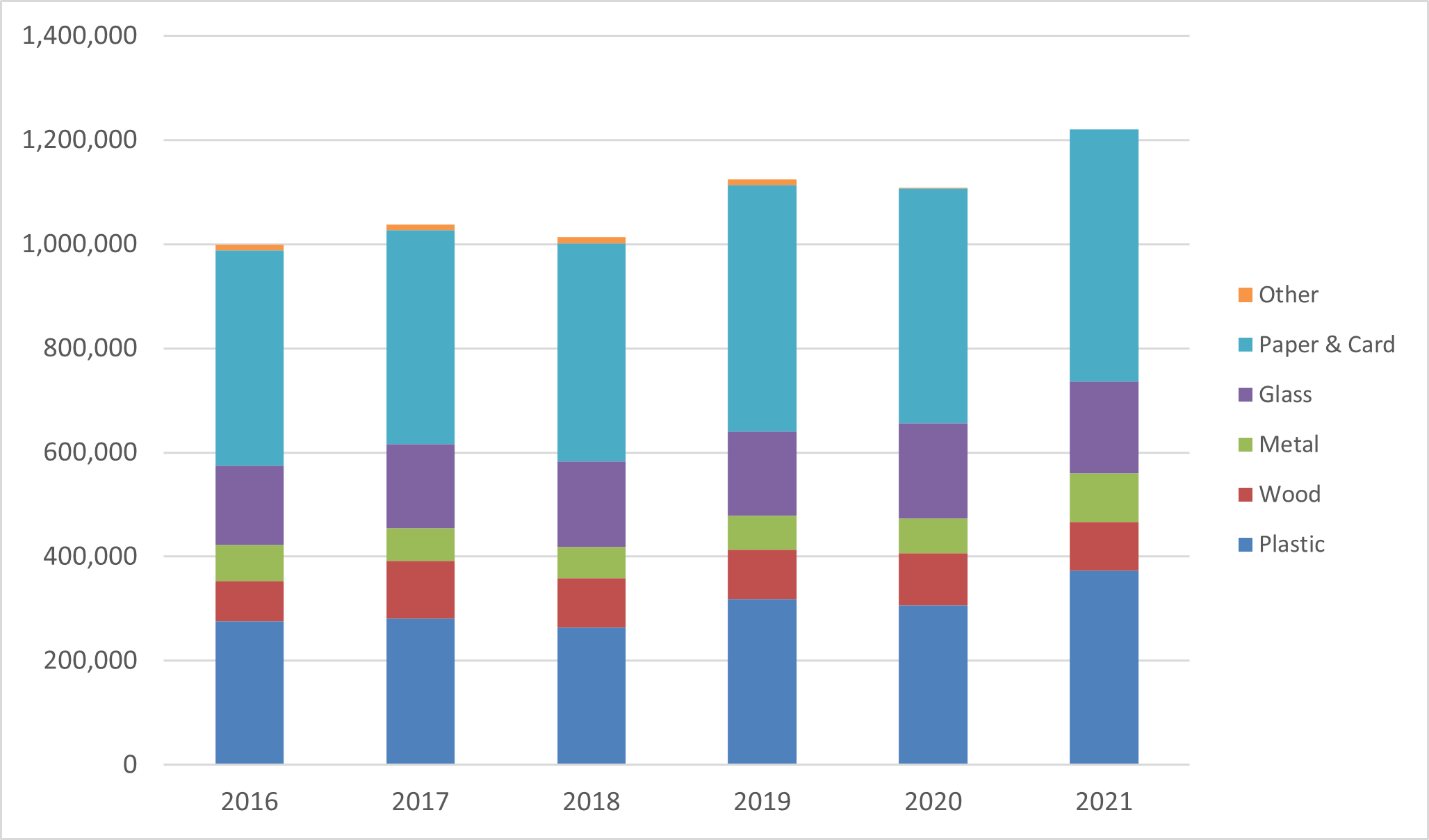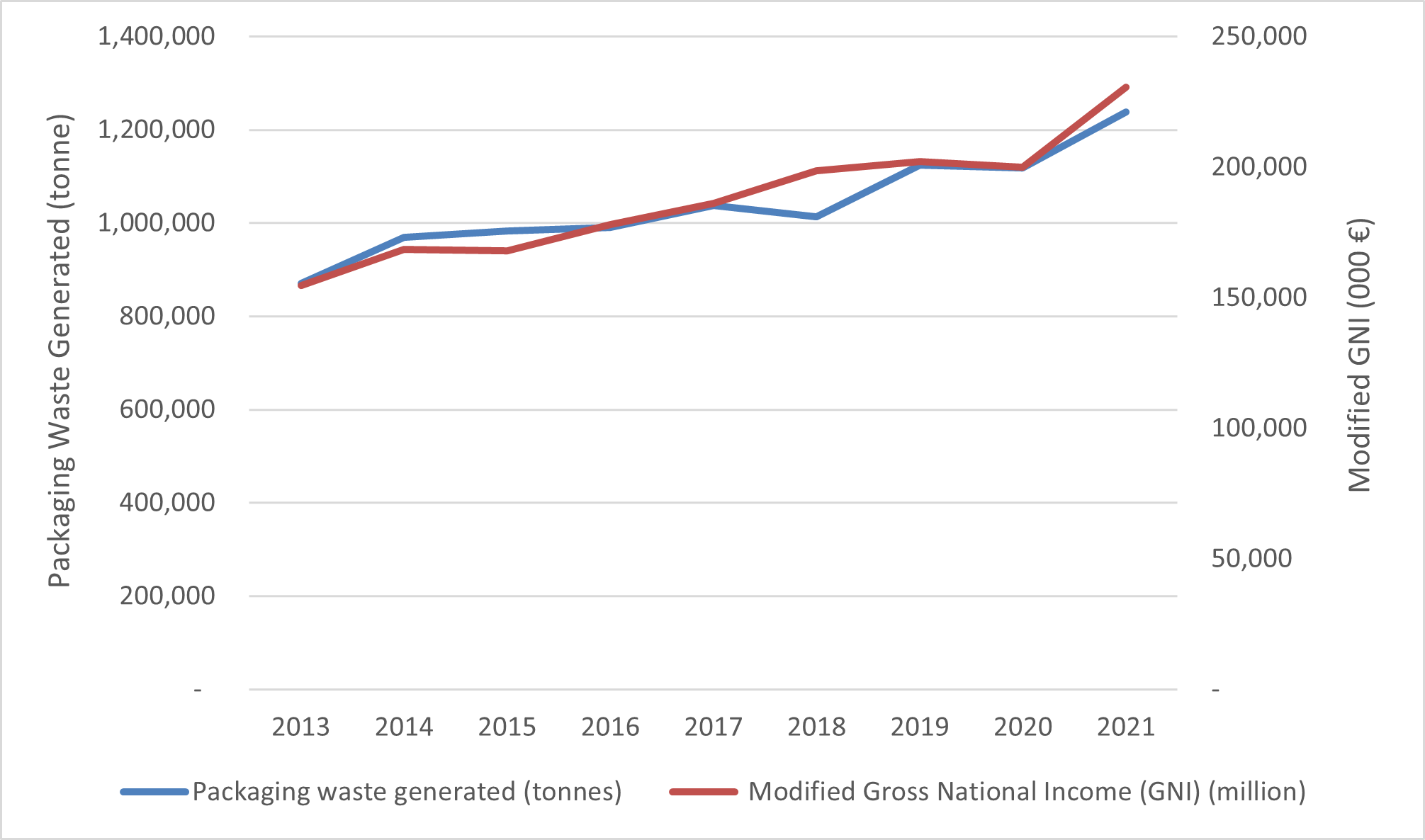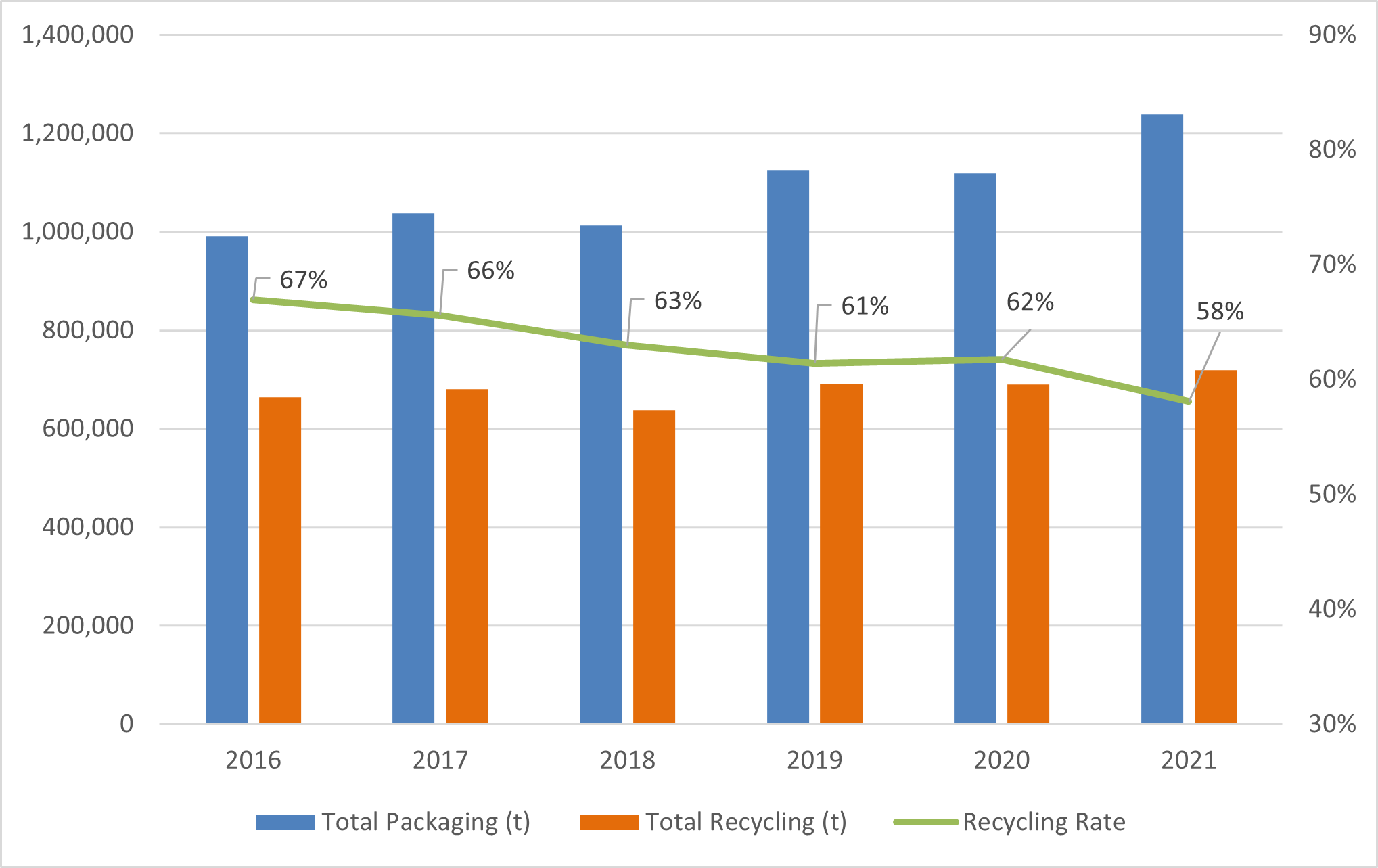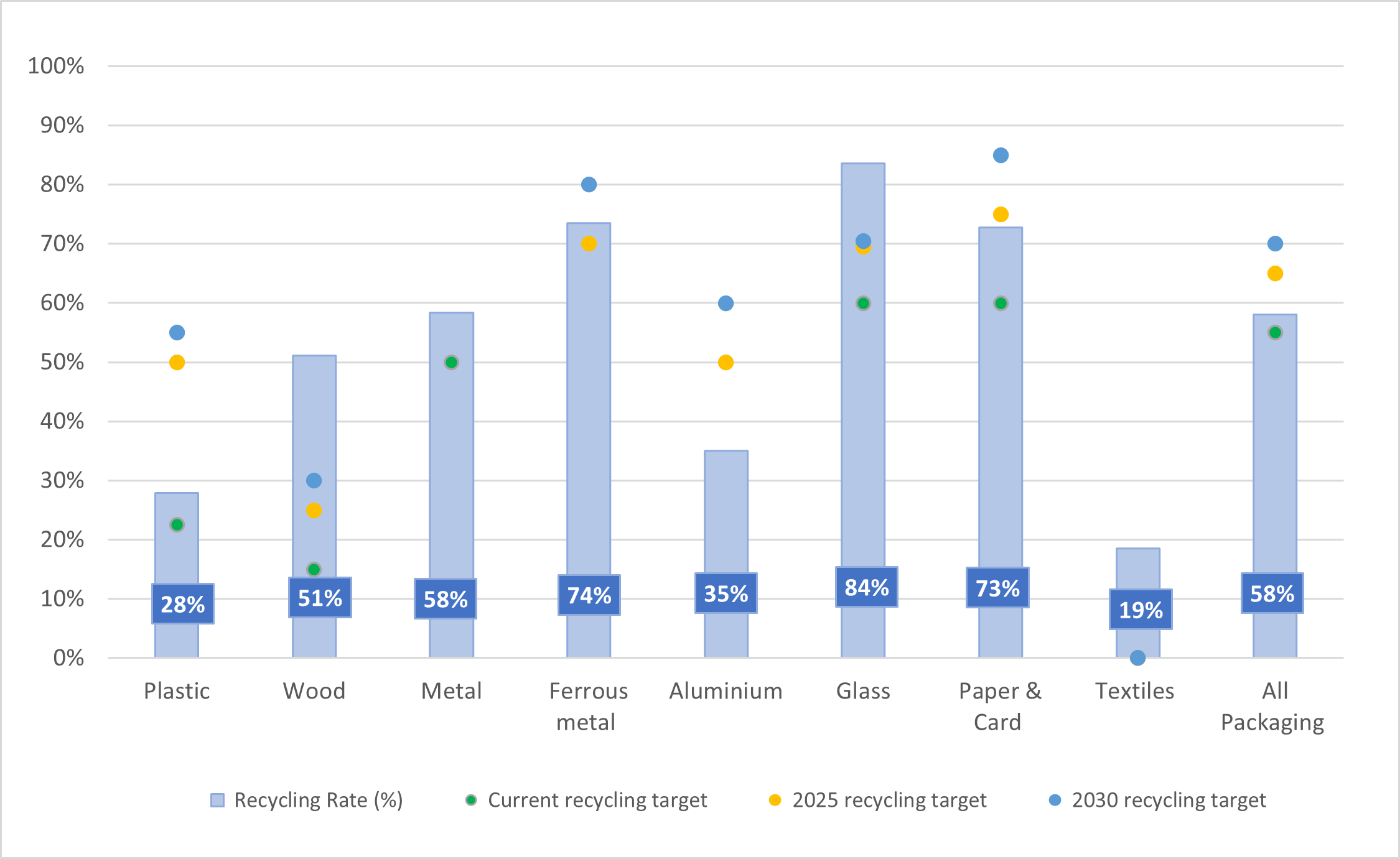EPA waste data release, 24 August 2023. Latest reference year 2021 (data subject to Eurostat validation)
Packaging comes with the products we buy for our homes and businesses. It protects them during transport, keeps them fresh and provides product information. Once the products are unpacked, the packaging become waste.
In 2021, Ireland generated 1.2 million tonnes of packaging waste.
The largest component of packaging waste is paper & cardboard followed by plastic, glass, wood, metal, see figure 1. For details on tonnes per material stream see table 1.
Packaging waste first breached the 1 million tonne mark in 2016 and it’s on an increasing trend of almost 25% based on the base year of 2016.
Packaging recycling has also increased, but at 8% on the base year of 2016, recycling is increasing three times slower than packaging waste generation. In 2021, there was an increase of 120,000 tonnes in packaging waste generated in comparison with 2020.

Table 1 Waste packaging generation and treatment 2021
| Material | Packaging waste generated | Recycling in Ireland | Recycling in Other EU Member States | Recycling Outside the EU | Total recycling | Total recycling Rate | Total Energy Recovery | Total Energy and Other Recovery Rate | Packaging waste Total Recovery (incl recycling) | ||
| Plastic | 372,819 | 26,048 | 47,929 | 30,216 | 104,193 | 28% | 260,760 | 70% | 98% | ||
| Wood (excl. wood repair)* | 96,716 | 49,408 | 0 | 49,408 | 51% | 43,501 | 45% | 96% | |||
| Metals | Ferrous Metal | 52,046 | 11,482 | 26,791 | 38,273 | 74% | 74% | ||||
| Aluminium Metal | 33,834 | 1,067 | 4,032 | 6,760 | 11,859 | 35% | 1,228 | 39% | |||
| Glass | 173,378 | 137,717 | 4,349 | 2,899 | 144,965 | 84% | 0 | 84% | |||
| Paper & Cardboard | 509,339 | 0 | 163,142 | 207,635 | 370,776 | 73% | 92,298 | 18% | 91% | ||
| Other (textiles) | 706 | 0 | 3 | 129 | 131 | 19% | 542 | 77% | 95% | ||
| Total | 1,238,838 | 225,722 | 219,454 | 274,429 | 719,606 | 58.1% | 398,329 | 32% | 90% | ||
| *Total incl. wood repair | 1,275,161 | 755,929 | 59.3% | 91% | |||||||
| Data table for 2021 reference year as submitted to the European Commission. | |||||||||||
| Data in tonnes unless otherwise specified. | |||||||||||
| *The EU reporting format requires that wooden packaging repaired for reuse (20,521 tonnes) is reported separately, however this can be included in the calculation of Ireland's recycling rate. | |||||||||||
Open in Excel: Table 1 Waste packaging generation, recycling and recovery in 2021 (XLS 13KB)
Open in CSV : Table 1 Waste packaging generation, recycling and recovery in 2021 (CSV 1KB)Recycling is part of the solution to packaging waste, and Ireland must achieve packaging targets set out in the EC Packaging and Packaging Waste Directive, however in a circular economy, packaging would be designed for reuse, rather than just a one use followed by recycling.
Reuse is preferable because recycling costs energy and uses resources, for example water for washing and fuel for transport and reprocessing. Designing packaging for multiple reuse trips makes the best use of raw materials, protects biodiversity from excessive extraction of raw materials, reduces emissions and reduces waste.

Ireland’s packaging generation correlates with economic indicators such as modified Gross National Income (GNI) see figure 2 above. Packaging generation and GNI have both resumed their upward trend that dipped in 2020 due to the Covid-19 pandemic. Ireland needs to decouple waste generation from economic performance and transition to a circular economy.
In 2021, Ireland recycled more tonnes than ever, and this can be seen by the increasing trend in the height of the orange bars in the chart in figure 3. However packaging waste generation, shown in blue bars in figure 3, is increasing faster than recycling. As a result, the recycling rate, the green line in figure 3, is on a decreasing trend.
Recycling cannot keep up with the rate of increase of packaging generation. Ireland’s packaging recycling rate decreased from 62% in 2020 to 58% in 2021.

We need to tackle waste generation so that we can
There are individual recycling targets for each material stream. In 2021, Ireland achieved the current recycling targets for paper & cardboard, plastic, glass, wood, metal, textiles, see green dot in Figure 4.

Ireland is already achieving the 2025 target for glass and wood, the yellow dot represents the targets for 2025. Recycling targets for 2025 separated out reporting for metals into metal types (ferrous and aluminium). Ireland is already achieving the 2025 target for ferrous metal. However, the 2025 target for plastic, aluminium and the overall packaging target are look increasingly unlikely to be achieved.
The blue dots represent the 2030 recycling targets, these will be challenging for all material streams except wood and glass.
According to data compiled by Repak, over 10,000 tonnes of reusable packaging were placed on the Irish market in 2021. This represented about 1% of all packaging placed on the market in 2021. This means that the remaining 99% of packaging waste consisted of single-use packaging. Examples of reusable packaging include wooden pallets, kegs, IBCs, trays, plastic boxed trays and buckets.
On the basis of multiple rotations of use, almost 93,000 tonnes of single-use packaging waste were avoided via repeat use of 10,000 tonnes of reusable packaging in Ireland in 2021.
According to Repak data, wood is the material stream with the highest level of reuse in Ireland, followed by ferrous metals and then plastic. There is a thriving demand for wood pallets, which are reused and repaired for reuse as a matter of course.
By 31 December 2024, the European Commission shall examine data on reusable packaging provided by Member States with a view to considering the feasibility of setting quantitative targets on reuse of packaging to promote this sector.
Reversing the rising trend in packaging waste generation and improving Ireland’s packaging recycling rates will require timely implementation of Ireland’s Waste Action Plan for Circular Economy and Circular Economy Act 2022 and consideration of measures to tackle waste generation including:
Ireland’s packaging waste generation and treatment figures are compiled by EPA using data obtained from waste operators (collectors and facilities), local authorities, and waste brokers and from Repak annually. Relevant characterisation factors are applied to the data for mixed waste streams to estimate the proportion of packaging based on the EPA’s most recent waste characterisation studies.
The data are cross-checked against data held by the National Waste Collection Permit Office and data reported to Repak, while exports are cross-checked against data from the National Transfrontier Shipment Office. Estimates for unmanaged waste are based on CSO data from the National Household Survey.
As part of annual reporting under the Packaging and Packaging Waste Directive, the EPA submits packaging waste statistics for Ireland to the Department of Environment, Climate and Communications for transmission to Eurostat, the statistical office of the European Union.
The data are required to be submitted by 30th June of the reference year +18 months (i.e. 2021 data were collected and processed in 2022 and submitted in June, 2023). Following validation by Eurostat, official statistics for Ireland and all Members are published on the Eurostat website as part of the following datasets: